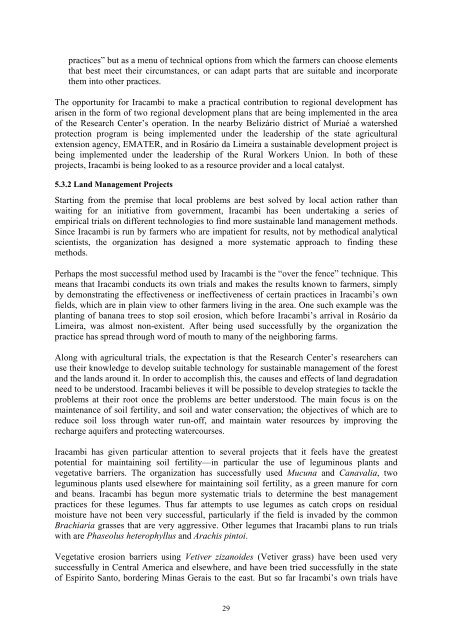Deforestation, Coffee Cultivation, and Land Degradation ... - lumes
Deforestation, Coffee Cultivation, and Land Degradation ... - lumes
Deforestation, Coffee Cultivation, and Land Degradation ... - lumes
You also want an ePaper? Increase the reach of your titles
YUMPU automatically turns print PDFs into web optimized ePapers that Google loves.
practices” but as a menu of technical options from which the farmers can choose elementsthat best meet their circumstances, or can adapt parts that are suitable <strong>and</strong> incorporatethem into other practices.The opportunity for Iracambi to make a practical contribution to regional development hasarisen in the form of two regional development plans that are being implemented in the areaof the Research Center’s operation. In the nearby Belizário district of Muriaé a watershedprotection program is being implemented under the leadership of the state agriculturalextension agency, EMATER, <strong>and</strong> in Rosário da Limeira a sustainable development project isbeing implemented under the leadership of the Rural Workers Union. In both of theseprojects, Iracambi is being looked to as a resource provider <strong>and</strong> a local catalyst.5.3.2 L<strong>and</strong> Management ProjectsStarting from the premise that local problems are best solved by local action rather thanwaiting for an initiative from government, Iracambi has been undertaking a series ofempirical trials on different technologies to find more sustainable l<strong>and</strong> management methods.Since Iracambi is run by farmers who are impatient for results, not by methodical analyticalscientists, the organization has designed a more systematic approach to finding thesemethods.Perhaps the most successful method used by Iracambi is the “over the fence” technique. Thismeans that Iracambi conducts its own trials <strong>and</strong> makes the results known to farmers, simplyby demonstrating the effectiveness or ineffectiveness of certain practices in Iracambi’s ownfields, which are in plain view to other farmers living in the area. One such example was theplanting of banana trees to stop soil erosion, which before Iracambi’s arrival in Rosário daLimeira, was almost non-existent. After being used successfully by the organization thepractice has spread through word of mouth to many of the neighboring farms.Along with agricultural trials, the expectation is that the Research Center’s researchers canuse their knowledge to develop suitable technology for sustainable management of the forest<strong>and</strong> the l<strong>and</strong>s around it. In order to accomplish this, the causes <strong>and</strong> effects of l<strong>and</strong> degradationneed to be understood. Iracambi believes it will be possible to develop strategies to tackle theproblems at their root once the problems are better understood. The main focus is on themaintenance of soil fertility, <strong>and</strong> soil <strong>and</strong> water conservation; the objectives of which are toreduce soil loss through water run-off, <strong>and</strong> maintain water resources by improving therecharge aquifers <strong>and</strong> protecting watercourses.Iracambi has given particular attention to several projects that it feels have the greatestpotential for maintaining soil fertility—in particular the use of leguminous plants <strong>and</strong>vegetative barriers. The organization has successfully used Mucuna <strong>and</strong> Canavalia, twoleguminous plants used elsewhere for maintaining soil fertility, as a green manure for corn<strong>and</strong> beans. Iracambi has begun more systematic trials to determine the best managementpractices for these legumes. Thus far attempts to use legumes as catch crops on residualmoisture have not been very successful, particularly if the field is invaded by the commonBrachiaria grasses that are very aggressive. Other legumes that Iracambi plans to run trialswith are Phaseolus heterophyllus <strong>and</strong> Arachis pintoi.Vegetative erosion barriers using Vetiver zizanoides (Vetiver grass) have been used verysuccessfully in Central America <strong>and</strong> elsewhere, <strong>and</strong> have been tried successfully in the stateof Espirito Santo, bordering Minas Gerais to the east. But so far Iracambi’s own trials have29
















